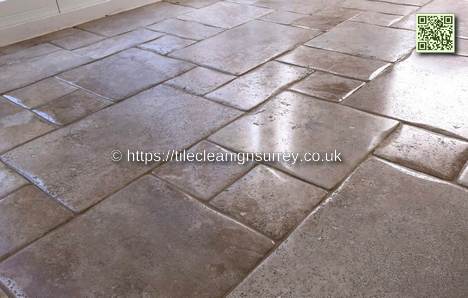This case study showcases the restoration of travertine tiles in high-traffic areas of a property in Chessington, Surrey. As the years passed, the once-beautiful travertine had lost its luster, becoming dull, stained, and worn. To restore its original elegance, we undertook a comprehensive project that included deep cleaning, filling natural holes, and applying a protective sealant. The result was a beautifully revitalized, low-maintenance floor that regained its natural charm and received long-lasting protection for future durability.
Travertine Floor Cleaning In Chessington – Key Points
- Thorough Cleaning is Crucial: A rotary scrubbing machine, heavy-duty travertine cleaners, and hot water pressurized rinse equipment remove ingrained soil that regular mopping can't tackle.
- Filling Holes Enhances Appearance and Durability: Addressing natural holes in the travertine improves its look and prevents future damage, ensuring the stone's longevity.
- Sealing Simplifies Maintenance: A properly applied sealer acts as a protective barrier, making future cleaning easier and preventing stains from setting in.
- Consistent Maintenance is Essential: A regular maintenance routine, including periodic resealing, keeps the travertine pristine and preserves its beauty for years.
Client Background:
This project focused on restoring travertine tiles in a Chessington home, where the kitchen, hallway, and w/c floors had suffered significant wear over the years. The homeowner sought a solution to bring back the natural beauty of the travertine while ensuring the floors would be easy to maintain and durable enough to withstand daily use. The restoration process involved deep cleaning, filling natural holes, and applying a protective sealant to achieve a clean, resilient surface that highlights the rich colors of the travertine.
 Project Background:
Project Background:
The travertine tiles, admired for their natural beauty and durability, had been in place for over a decade. Over time, the tiles lost their smooth finish, with soil accumulating in the pits and voids. The grout was discoloured, diminishing the floor's overall look. The project involved deep cleaning the tiles, filling the natural holes, and applying a protective sealer to restore the floor's appearance and enhance its long-term resilience.
Challenges Encountered During the Project
- Deeply Embedded Dirt: Years of foot traffic had caused dirt to become ingrained in the natural pits and voids of the travertine, making it difficult to clean with standard methods.
- Natural Holes: Travertine tiles' inherent holes and gaps trap the dirt and add to the floor's worn appearance.
- Stained Grout: Over time, the grout between the tiles had become heavily stained, further diminishing the floor's visual appeal.
- High Traffic Areas: The constant use of these spaces required a restoration approach that effectively revitalized the floor while minimizing disruption to the household.
Solution and Process:
Step 1: Assessment and Planning
The initial assessment identified the level of soiling and wear on the travertine tiles. Based on these findings, a plan was crafted to remove the ingrained dirt, fill the natural holes, and apply a protective sealer to restore the tiles and improve their durability.
Step 2: Cleaning Process
We prepared the work area by removing small pieces of furniture and clearing loose debris with brushing and vacuuming. After applying a diluted travertine cleaner and letting it soak for ten minutes, we used a rotary scrubbing machine with a medium-grade brush to remove the surface soil. We used hot-water rinse and capture equipment to tackle the dirt trapped in the holes and pits, effectively lifting the remaining soils and restoring the travertine’s clean surface.
Step 3: Filling Natural Holes
Step 4: Sealing the Floor
We applied a hybrid satin finish sealer with a roller, creating a mid-sheen look. This sealant formed a protective barrier against stains and dirt, making the floor easier to maintain. We ensured full coverage and a consistent finish during the sealing process.
Project Timeline:
We completed the project in two days, from assessment to final touches.
Project Results:
We restored the travertine to its original finish by removing ingrained soil and stains, revealing the natural colours of the tiles. The client expressed her delight with the results, commenting that the floor “looked as good as new”. The protective sealer now keeps the travertine low-maintenance and durable, preserving its beauty and functionality for the long term. This project turned a dull, worn floor into a revitalized, stunning surface.
Conclusion:
This travertine cleaning project in Chessington restored the tiles' natural beauty, making them a durable and low-maintenance flooring solution for the homeowner. We significantly enhanced the floor’s appearance and extended its longevity through deep cleaning, precise filling, and effective sealing. This case study highlights the value of professional cleaning and maintenance for natural stone surfaces like travertine.
If your travertine floor needs cleaning or restoration, contact us today for a consultation. Our expert services will keep your natural stone surfaces beautiful and functional for years to come.
Frequently Asked Questions
How Long Does the Travertine Cleaning Process Take?
The travertine cleaning usually takes several hours, depending on the floor’s condition. Thorough cleaning techniques remove ingrained soil and prepare the tiles for sealing, which helps prolong their lifespan.
Is It Safe to Use DIY Cleaning Products on Travertine?
Homemade cleaning solutions on travertine can be risky due to potential chemical reactions that may harm the stone. For this reason, it’s safer to use pH-balanced cleaners specifically designed for natural stone to ensure effective and safe cleaning.
Can Travertine Floors Be Installed Over Existing Tile?
Yes, travertine floors can be installed over existing tiles. Proper installation requires assessing the underlying surface and potentially levelling it to ensure a stable, long-lasting finish.
What Is the Cost Range for Travertine Floor Cleaning Services?
The cost of travertine floor cleaning services typically ranges from £3 to £5 per square foot. The price varies depending on the cleaning methods, soiling, and the condition of the tiles.
How Often Should Travertine Floors Be Professionally Cleaned?
Travertine floors should be professionally cleaned every 12 to 18 months. Regular maintenance, including prompt spill management and periodic sealing, will help preserve the stone’s natural beauty and longevity.
The post Travertine Floor Cleaning In Chessington Surrey. Sponsored by: Travertine Cleaning Chessington
The Article Reviving Travertine Floors in Chessington, Surrey appeared first on https://fabritec.org
The Article Reviving Travertine Floors in Chessington, Surrey Was Found On https://limitsofstrategy.com
The Article Reviving Travertine Floors in Chessington, Surrey First Appeared ON
: https://ad4sc.com


Restoring travertine tiles sounds like quite the project! It’s fascinating how natural stone can tell a story through its wear and tear over the years, isn’t it? I’ve always been drawn to the unique beauty of travertine, with its warm hues and textures, but I had no idea just how much effort goes into maintaining it, especially in high-traffic areas like yours in Chessington.
Restoring travertine tiles is definitely a labor of love, and it’s interesting how much these stones can reflect the stories of their surroundings. Each scratch and stain can hint at moments in our lives, and I often find myself thinking about all the feet that have walked over these tiles in my home.
Restoring travertine tiles really does feel like a journey through time, doesn’t it? Each mark seems to whisper a story, making me think about how our homes are not just spaces but archives of our lives. I’ve often noticed that, just like the tiles in your home, the surfaces around us can carry the weight of memories—each scuff could evoke a family gathering, a pet’s playful antics, or even just the daily hustle and bustle of life.
You make a great point about how our spaces are intertwining with our stories. Each scratch or discoloration isn’t just a flaw—it’s a reminder of moments that shaped our lives. I’ve often felt that the character of travertine tiles reflects the rhythm of everyday life, capturing everything from quiet afternoons to lively gatherings.
Absolutely, it’s fascinating how every mark on those tiles can spark a memory! If you’re looking to give your own travertine a fresh look while preserving its history, check out this guide for restoring those cherished surfaces.
https://oldicom.net/webilaro
Restoring travertine tiles really is a fascinating project, and I completely agree that natural stone has such a rich story behind it. The warm hues and unique textures definitely create a beautiful ambiance, but it’s interesting to think about the effort involved in preserving that beauty over time, especially in high-traffic areas like you mentioned.
It’s interesting to see how seemingly small details, like the condition of travertine flooring, can significantly affect the overall aesthetic and functionality of a space. Your detailed approach to restoration highlights the importance of preventive maintenance, which is often overlooked in high-traffic areas.
You’re spot on about how those little details can really shape a space. I’ve noticed that travertine flooring often gets taken for granted until it starts showing wear. It’s not just about looks; the condition of the flooring can impact safety and comfort, too.
“Absolutely! Investing in regular maintenance can make all the difference—check out our guide on travertine care for tips that can enhance your space’s beauty and longevity.”
https://oldicom.net/webilaro
You make a great point about the condition of travertine flooring. It’s fascinating how such small details can change how we feel in a space. I’ve noticed that people often underestimate the impact of their environment on mood and productivity. For instance, I remember visiting a café with worn-down floors; it didn’t feel inviting, even though the coffee was great.
You’ve touched on something really intriguing. Those small details, like the condition of flooring, can create a certain vibe that resonates with us. It’s almost like a silent language that speaks to our subconscious. Your café example is spot on; it shows how even a worn-out floor can overshadow a great experience.
The condition of travertine flooring often gets pushed aside in conversations about design or functionality, which is a shame because those little details can turn a mundane space into something remarkable, or just the opposite. People tend to notice the grand elements like furniture or artwork, but the flooring is the foundation of any room’s aesthetic. When it’s well cared for, it can really tie everything together and create a cohesive look.
You make a great point about the impact of those small details, like the condition of travertine flooring, on a space’s overall vibe. It’s fascinating how something that seems purely aesthetic can also influence how a space functions. I recently read about how different flooring materials can impact acoustic qualities in a room, which adds another layer to the conversation around design choices.
I found an insightful piece that dives into what you can expect when professionals take the reins on terracotta tile installation, emphasizing how their expertise can truly elevate both aesthetics and durability in your home.
‘When Experts Handle Your Terracotta Tile Installation What You Can Anticipate’
https://oldicom.net/when-experts-handle-your-terracotta-tile-installation-what-you-can-anticipate/.
This case study really highlights the importance of maintaining natural stone flooring, especially in high-traffic areas. I’ve seen how travertine can transform a space, but it’s easy to overlook the care it needs. The deep cleaning process you described must have made a huge difference in restoring not just the floor’s appearance but also its structural integrity.
It’s interesting you mention the transformation that travertine can bring to a space. There’s something undeniably warm and inviting about natural stone that artificial materials just can’t replicate. I’ve always felt that maintaining these surfaces not only enhances their aesthetics but also contributes to the overall atmosphere of a home.
You make a great point about the importance of maintaining natural stone flooring, especially when it comes to the aesthetics and longevity of materials like travertine. It has such a unique charm and can truly elevate the ambiance of a space. I’ve found that people often underestimate the impact of the environment around them, and a well-kept floor can really set the tone for the entire room.
It’s great to hear your thoughts on the case study. You’re right; the maintenance of natural stone flooring, particularly in high-traffic areas, can easily slip under the radar. Travertine, with its unique textures and earthy tones, can really bring a room to life, offering a warmth that many other flooring materials just can’t match. However, that beauty does come with its own set of challenges.
This post definitely resonates with me! I once saw travertine tiles in a friend’s house that looked like they had been hit by a battalion of muddy boots during a monsoon. I had no idea how beautiful they could be until I witnessed the transformation after a proper cleaning and sealing. It’s like watching a superhero get their cape back!
I found your case study on travertine tile restoration really insightful, especially since I’ve been considering a similar project for the flooring in my own home. Seeing how the tiles can lose their luster over time resonates with anyone who has invested in beautiful stone flooring. I remember when I moved into my current home, the previous owners had installed travertine, and while I loved the aesthetics, it quickly became apparent that maintenance was going to be a challenge. Regular cleaning just didn’t cut it, and it felt like I was fighting a losing battle.